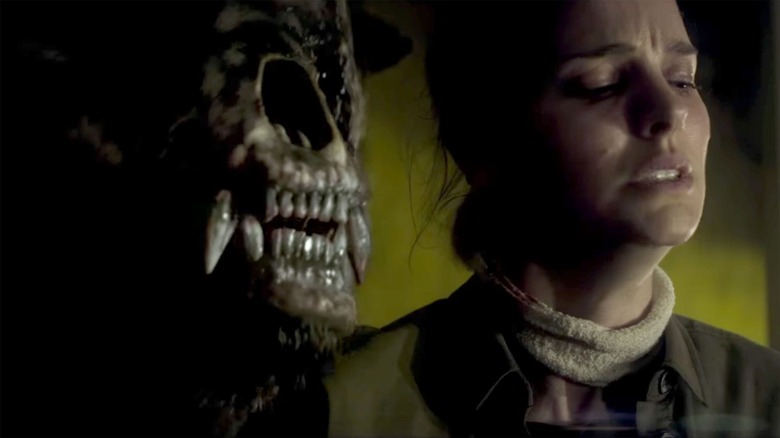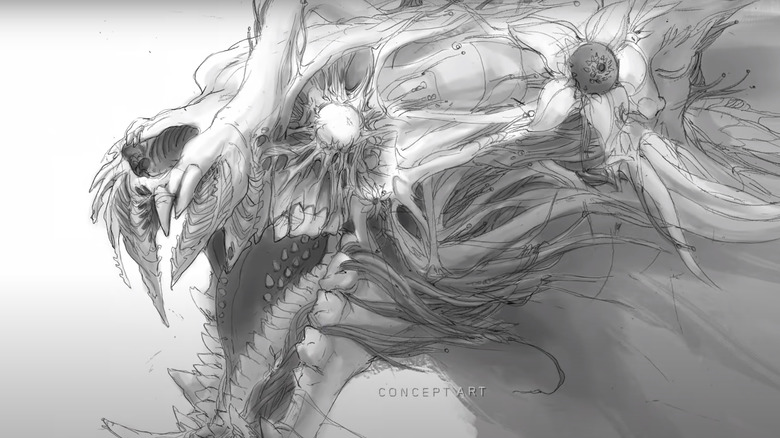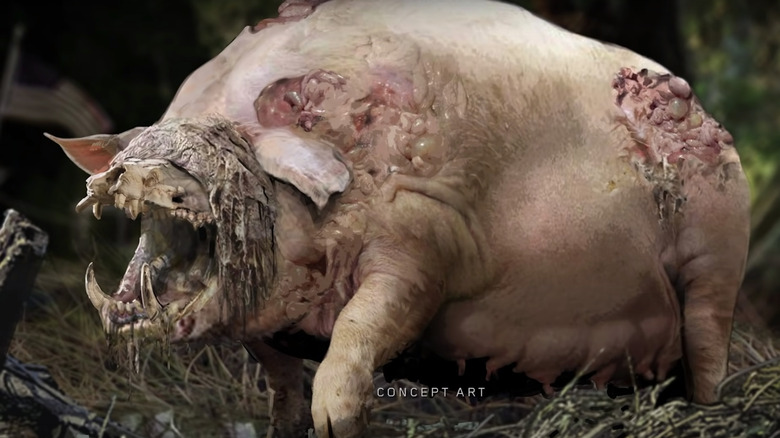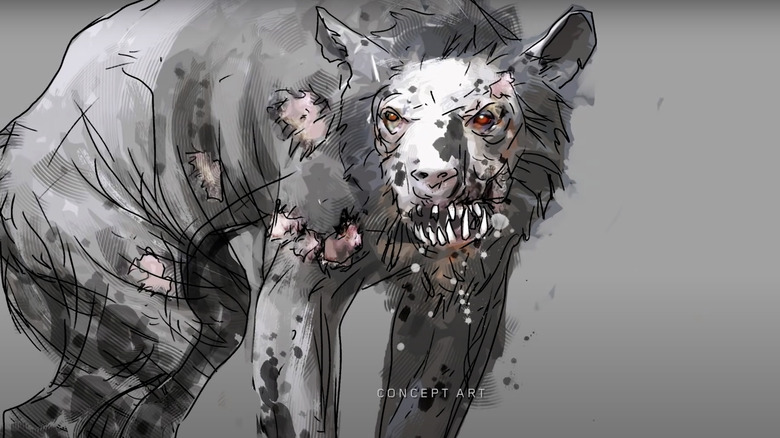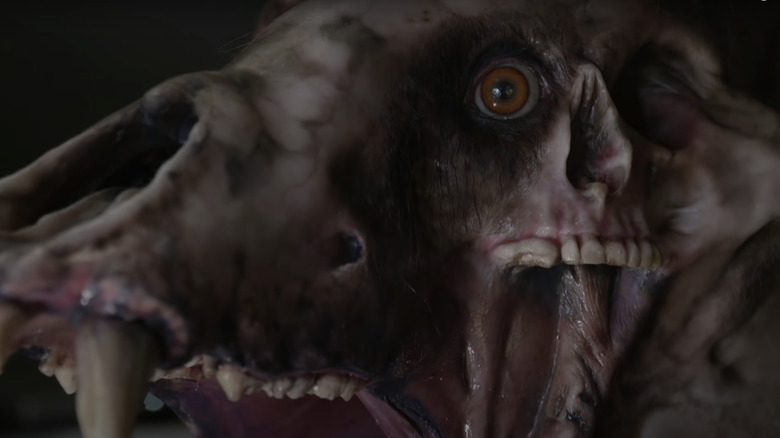How The Horrifying Annihilation Bear Creature Came To Life
Although it flopped at the box office, Alex Garland's 2018 sci-fi epic "Annihilation" prevails as one of the most inventive (and down-right bone-chilling) genre films of the past five years. Making only $43 million against its $45-55 million budget, "Annihilation" could have simply faded into obscurity — but instead it became a beloved cult classic, with its heady thematic investigation into the destructive nature of humanity highlighted as one of its strongest elements. However, one of the film's other strengths — and perhaps why it's endured among sci-fi and horror hounds — is the disturbing violence and creature design it utilizes. There are mutant crocodiles, metallic humanoids, and alien fungi, but nothing quite stands out like the film's horrifying bear creature.
If you need a refresher, "Annihilation" follows a crew of research scientists — comprised of an A-Team of actors including Natalie Portman, Jennifer Jason Leigh, Tessa Thompson and Gina Rodriguez — who embark on a perilous journey through "The Shimmer," a biohazardous zone that seems to warp and mutate the DNA of all flora and fauna that comes into contact with it. Unsurprisingly, this meteor-incited phenomenon is responsible for spawning the aforementioned terrifying bear beast, but the process behind conceptualizing this creature is just as fascinating as the science-fiction that propels the movie's plot. Adapted from the novel of the same name by Jeff VanderMeer, Garland and his team of creatives revealed just how extensively their own artistic process bounced off VanderMeer's original concept in an exclusive /Film video.
From the Bear-y Beginning
While the film is based on VanderMeer's novel, Garland took enormous creative liberty with the adaptation. As opposed to faithfully adapting the novel (which acts as the first book of the "Southern Reach" trilogy), the director wanted the film to evoke the dreamlike state he felt while reading the book. This meant Garland would expand on themes and ideas in lieu of translating the novel's narrative onto the screen. Basically, a lot of artistic heavy-lifting would be required of the entire production team, perhaps none more than the skilled VFX team — many returning after previously working with Garland on his 2014 directorial breakthrough "Ex Machina." The bear was just one of these original elements, concocted in Garland's script and then assigned to the VFX team for filmic realization.
In the interview, concept artist Jock explains that the bear was one of the first things the team knew they needed to tackle, but the road to its gruesome manifestation in "Annihilation" wasn't as clear-cut as one might expect, with an equally terrifying animal nearly standing-in for the uncanny ursid.
It Was Almost a Boar-y Beginning
Any brainstorming session will typically yield some off-the-cuff craziness, and the concept art for this idea alone is nearly as terrifying as the final result. Apparently, a boil-laden boar with a gaping maw was nearly green-lit during the early stages of design.
One of the "strange ideas" that Visual Effects Supervisor Andrew Whitehurst alludes to in the interview is that, during early development, there was a version of the story that saw this creature as a mutated boar instead of a bear. The primordial human fear of bears ultimately winning out over that of wild boars makes total sense in the long-run — but is anyone else definitely going to have nightmares over this diseased, man-eating pig with pustules?
Pestilence as Inspiration
Clearly, an animal affected by alien-induced mutations isn't going to look anywhere near natural. But integrating the very real diseases that often ravage wildlife brought an entirely new element of gross-out fear to the creature. Jock jokingly references this process as having not been a "good day at the office," but adamantly defends the necessity of looking at real-life references for this fantastical feral beast, even going so far as saying that the bear's "sick look" is what Garland really responded to.
There are definitely hints of mange and rabies in the bear's physical appearance, but it's sci-fi slant is never as evident (or as petrifying) as when it effectively replicates human speech. "Help me," it cries in Cass' (Tuva Novotny) voice in order to lure an unsuspecting (and clearly unhinged) Anya (Rodriguez) toward her. This disturbing development is just one of the changes imparted onto the animal by "The Shimmer."
Mutilation and Mutation
What's most unsettling about this blood-thirsty creature is its relative proximity to humanity, evident in its ability to mimic human voices and possession of weirdly hominoid anatomical features. Human bones, teeth, and skulls all fuse together on top of the bear's own genetically warped anatomy, producing a truly disquieting creature with recognizable flashes of humanity superimposed onto its monstrous body. One concept artist even notes that this amalgamation of remains is likely due to the fact that the creature absorbs corporeal refuse after attacking or devouring an unlucky passerby, making the mutation all the more unsettling.
In particular, Whitehurst gives kudos to Peter Ocampo, a U.K.-based concept artist, for coming up with the idea of incorporating human skulls into the creature's design. He states that the artist simply began mashing together skulls and painting over the result to really cement the beast's visual makeup, a kernel of an idea that truly morphed into something incredibly smart and scary.
While some are sure to be paralyzed by the tension of the infamous "bear scene" during that fateful first viewing, it's clear that audiences can truly appreciate the artistry inherent in the bear's perturbing presence upon subsequent watches. So why not boot up "Annihilation" for a round-two rewatch? With all of the early buzz surrounding Garland's forthcoming film "Men," it's well worth it to delve back into this consistently brilliant director's filmography.
